2003 FORD F SERIES MOTORHOME AND COMMERCIAL CHASSIS warning light
[x] Cancel search: warning lightPage 25 of 96
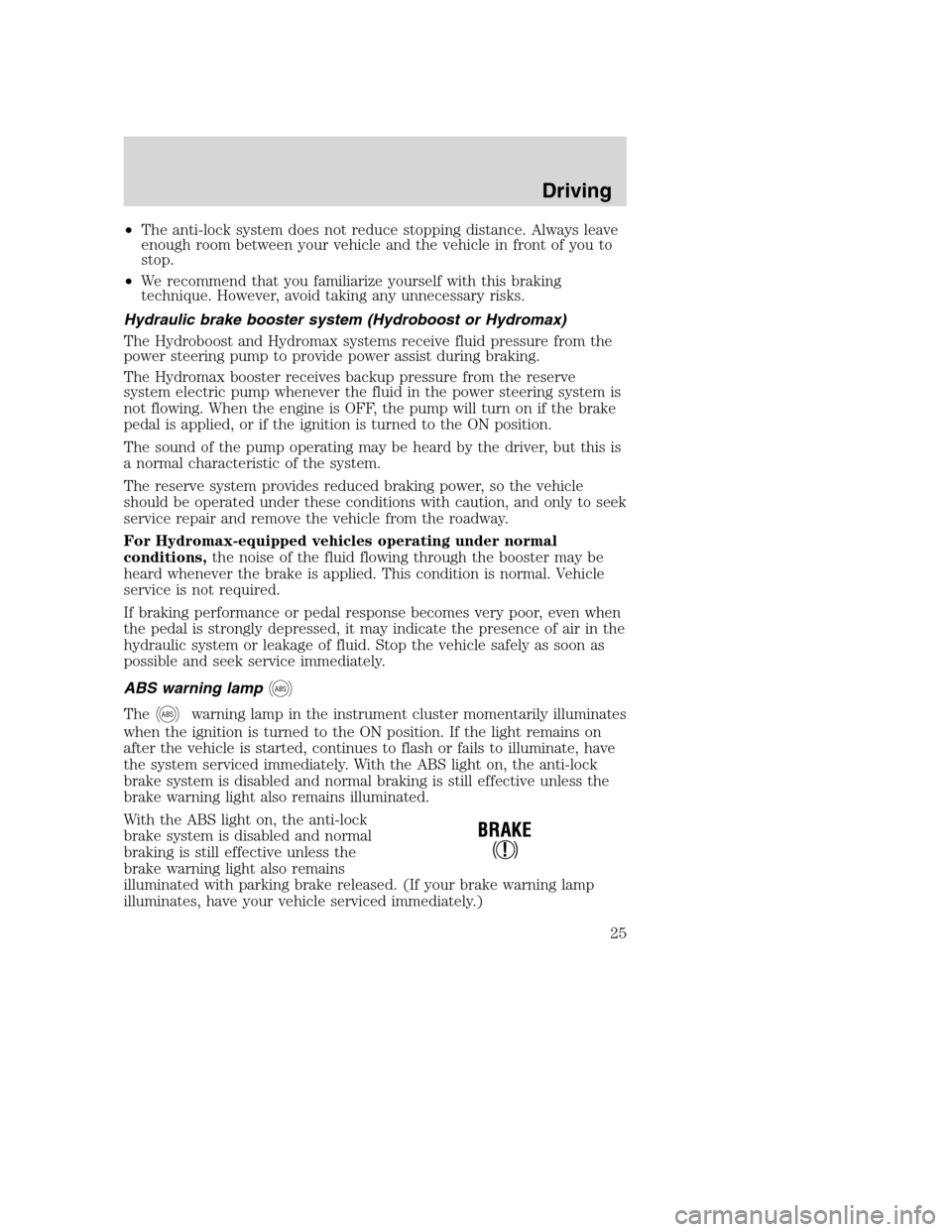
•The anti-lock system does not reduce stopping distance. Always leave
enough room between your vehicle and the vehicle in front of you to
stop.
•We recommend that you familiarize yourself with this braking
technique. However, avoid taking any unnecessary risks.
Hydraulic brake booster system (Hydroboost or Hydromax)
The Hydroboost and Hydromax systems receive fluid pressure from the
power steering pump to provide power assist during braking.
The Hydromax booster receives backup pressure from the reserve
system electric pump whenever the fluid in the power steering system is
not flowing. When the engine is OFF, the pump will turn on if the brake
pedal is applied, or if the ignition is turned to the ON position.
The sound of the pump operating may be heard by the driver, but this is
a normal characteristic of the system.
The reserve system provides reduced braking power, so the vehicle
should be operated under these conditions with caution, and only to seek
service repair and remove the vehicle from the roadway.
For Hydromax-equipped vehicles operating under normal
conditions,the noise of the fluid flowing through the booster may be
heard whenever the brake is applied. This condition is normal. Vehicle
service is not required.
If braking performance or pedal response becomes very poor, even when
the pedal is strongly depressed, it may indicate the presence of air in the
hydraulic system or leakage of fluid. Stop the vehicle safely as soon as
possible and seek service immediately.
ABS warning lamp
ABS
TheABSwarning lamp in the instrument cluster momentarily illuminates
when the ignition is turned to the ON position. If the light remains on
after the vehicle is started, continues to flash or fails to illuminate, have
the system serviced immediately. With the ABS light on, the anti-lock
brake system is disabled and normal braking is still effective unless the
brake warning light also remains illuminated.
With the ABS light on, the anti-lock
brake system is disabled and normal
braking is still effective unless the
brake warning light also remains
illuminated with parking brake released. (If your brake warning lamp
illuminates, have your vehicle serviced immediately.)
Driving
25
Page 43 of 96
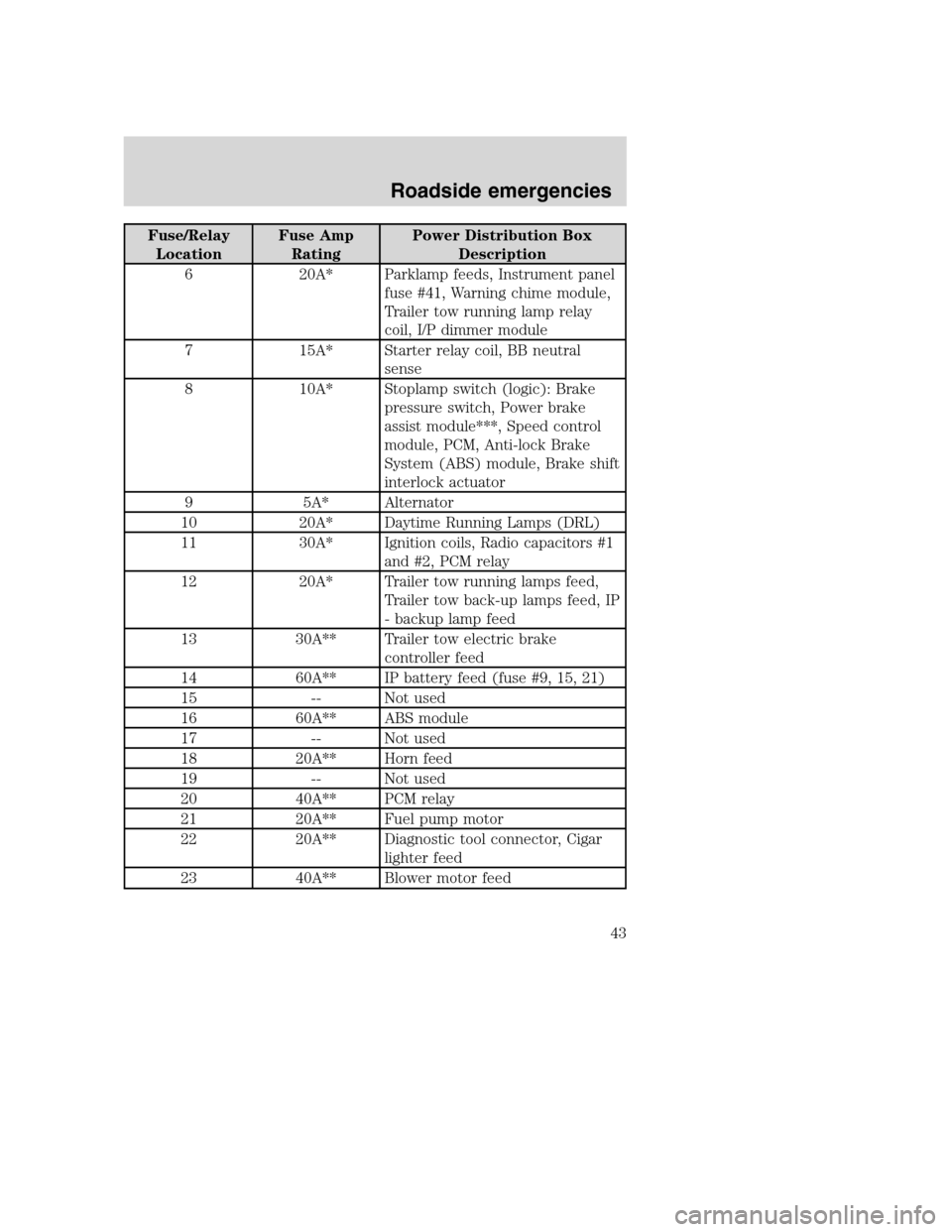
Fuse/Relay
LocationFuse Amp
RatingPower Distribution Box
Description
6 20A* Parklamp feeds, Instrument panel
fuse #41, Warning chime module,
Trailer tow running lamp relay
coil, I/P dimmer module
7 15A* Starter relay coil, BB neutral
sense
8 10A* Stoplamp switch (logic): Brake
pressure switch, Power brake
assist module***, Speed control
module, PCM, Anti-lock Brake
System (ABS) module, Brake shift
interlock actuator
9 5A* Alternator
10 20A* Daytime Running Lamps (DRL)
11 30A* Ignition coils, Radio capacitors #1
and #2, PCM relay
12 20A* Trailer tow running lamps feed,
Trailer tow back-up lamps feed, IP
- backup lamp feed
13 30A** Trailer tow electric brake
controller feed
14 60A** IP battery feed (fuse #9, 15, 21)
15 -- Not used
16 60A** ABS module
17 -- Not used
18 20A** Horn feed
19 -- Not used
20 40A** PCM relay
21 20A** Fuel pump motor
22 20A** Diagnostic tool connector, Cigar
lighter feed
23 40A** Blower motor feed
Roadside emergencies
43
Page 77 of 96
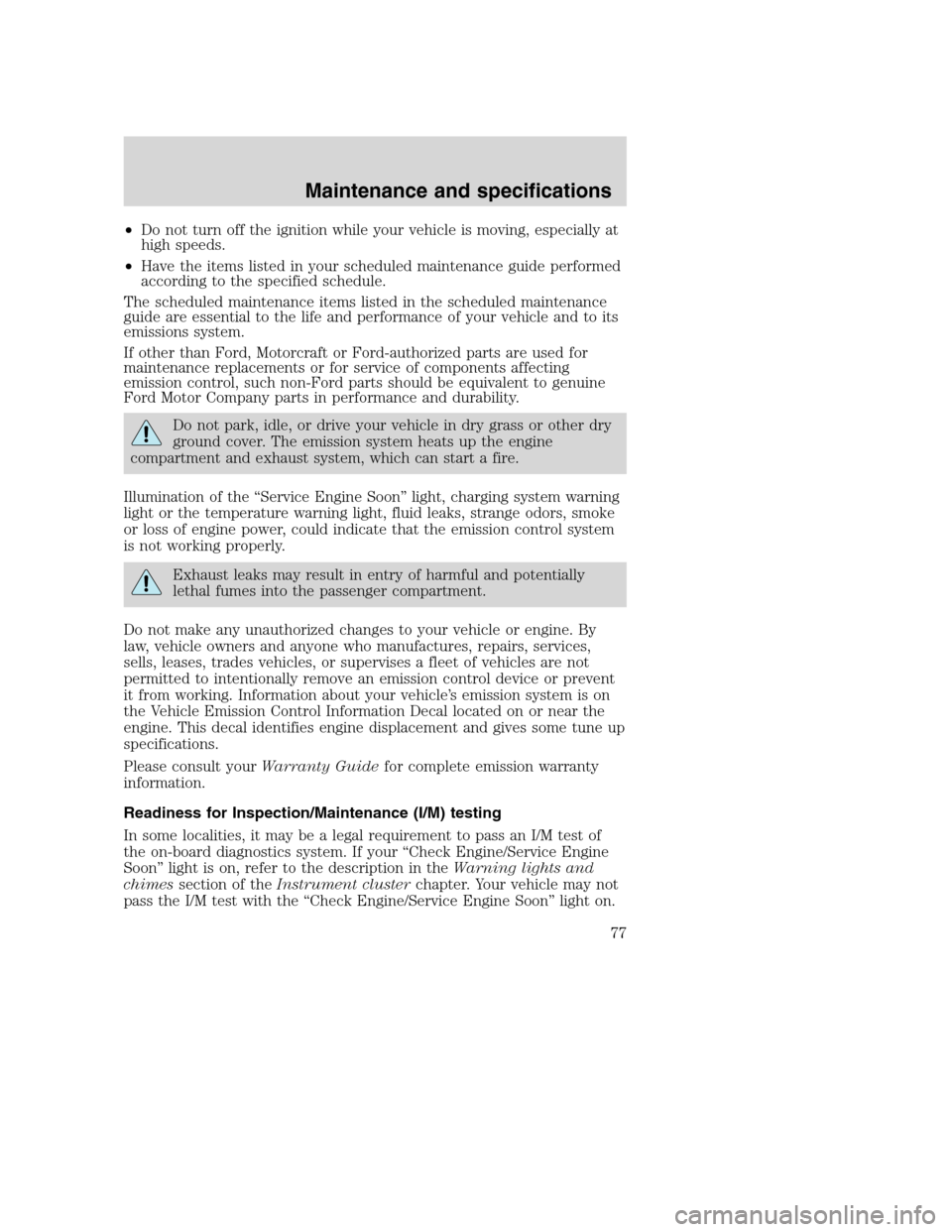
•Do not turn off the ignition while your vehicle is moving, especially at
high speeds.
•Have the items listed in your scheduled maintenance guide performed
according to the specified schedule.
The scheduled maintenance items listed in the scheduled maintenance
guide are essential to the life and performance of your vehicle and to its
emissions system.
If other than Ford, Motorcraft or Ford-authorized parts are used for
maintenance replacements or for service of components affecting
emission control, such non-Ford parts should be equivalent to genuine
Ford Motor Company parts in performance and durability.
Do not park, idle, or drive your vehicle in dry grass or other dry
ground cover. The emission system heats up the engine
compartment and exhaust system, which can start a fire.
Illumination of the “Service Engine Soon” light, charging system warning
light or the temperature warning light, fluid leaks, strange odors, smoke
or loss of engine power, could indicate that the emission control system
is not working properly.
Exhaust leaks may result in entry of harmful and potentially
lethal fumes into the passenger compartment.
Do not make any unauthorized changes to your vehicle or engine. By
law, vehicle owners and anyone who manufactures, repairs, services,
sells, leases, trades vehicles, or supervises a fleet of vehicles are not
permitted to intentionally remove an emission control device or prevent
it from working. Information about your vehicle’s emission system is on
the Vehicle Emission Control Information Decal located on or near the
engine. This decal identifies engine displacement and gives some tune up
specifications.
Please consult yourWarranty Guidefor complete emission warranty
information.
Readiness for Inspection/Maintenance (I/M) testing
In some localities, it may be a legal requirement to pass an I/M test of
the on-board diagnostics system. If your “Check Engine/Service Engine
Soon” light is on, refer to the description in theWarning lights and
chimessection of theInstrument clusterchapter. Your vehicle may not
pass the I/M test with the “Check Engine/Service Engine Soon” light on.
Maintenance and specifications
77
Page 86 of 96
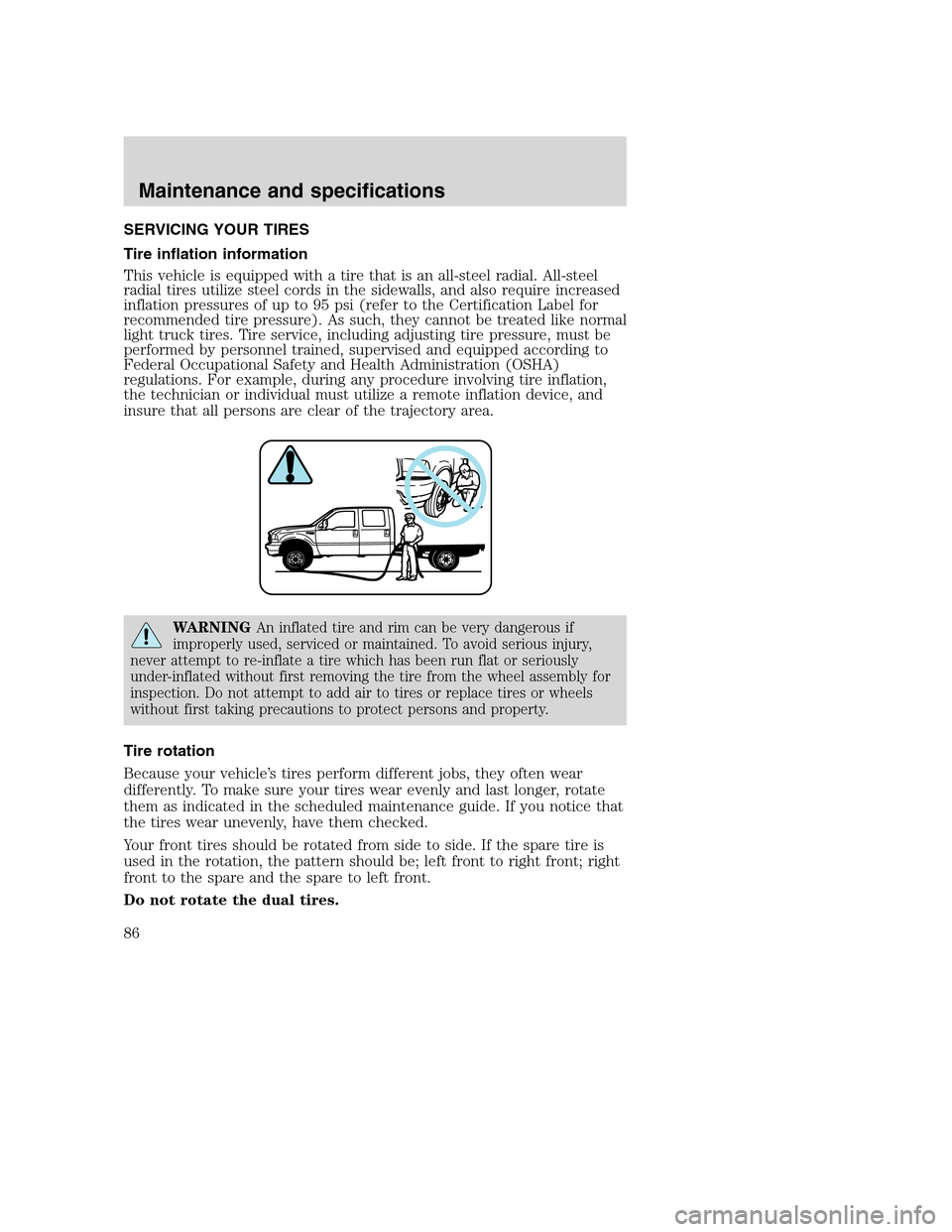
SERVICING YOUR TIRES
Tire inflation information
This vehicle is equipped with a tire that is an all-steel radial. All-steel
radial tires utilize steel cords in the sidewalls, and also require increased
inflation pressures of up to 95 psi (refer to the Certification Label for
recommended tire pressure). As such, they cannot be treated like normal
light truck tires. Tire service, including adjusting tire pressure, must be
performed by personnel trained, supervised and equipped according to
Federal Occupational Safety and Health Administration (OSHA)
regulations. For example, during any procedure involving tire inflation,
the technician or individual must utilize a remote inflation device, and
insure that all persons are clear of the trajectory area.
WARNINGAn inflated tire and rim can be very dangerous if
improperly used, serviced or maintained. To avoid serious injury,
never attempt to re-inflate a tire which has been run flat or seriously
under-inflated without first removing the tire from the wheel assembly for
inspection. Do not attempt to add air to tires or replace tires or wheels
without first taking precautions to protect persons and property.
Tire rotation
Because your vehicle’s tires perform different jobs, they often wear
differently. To make sure your tires wear evenly and last longer, rotate
them as indicated in the scheduled maintenance guide. If you notice that
the tires wear unevenly, have them checked.
Your front tires should be rotated from side to side. If the spare tire is
used in the rotation, the pattern should be; left front to right front; right
front to the spare and the spare to left front.
Do not rotate the dual tires.
Maintenance and specifications
86
Page 94 of 96
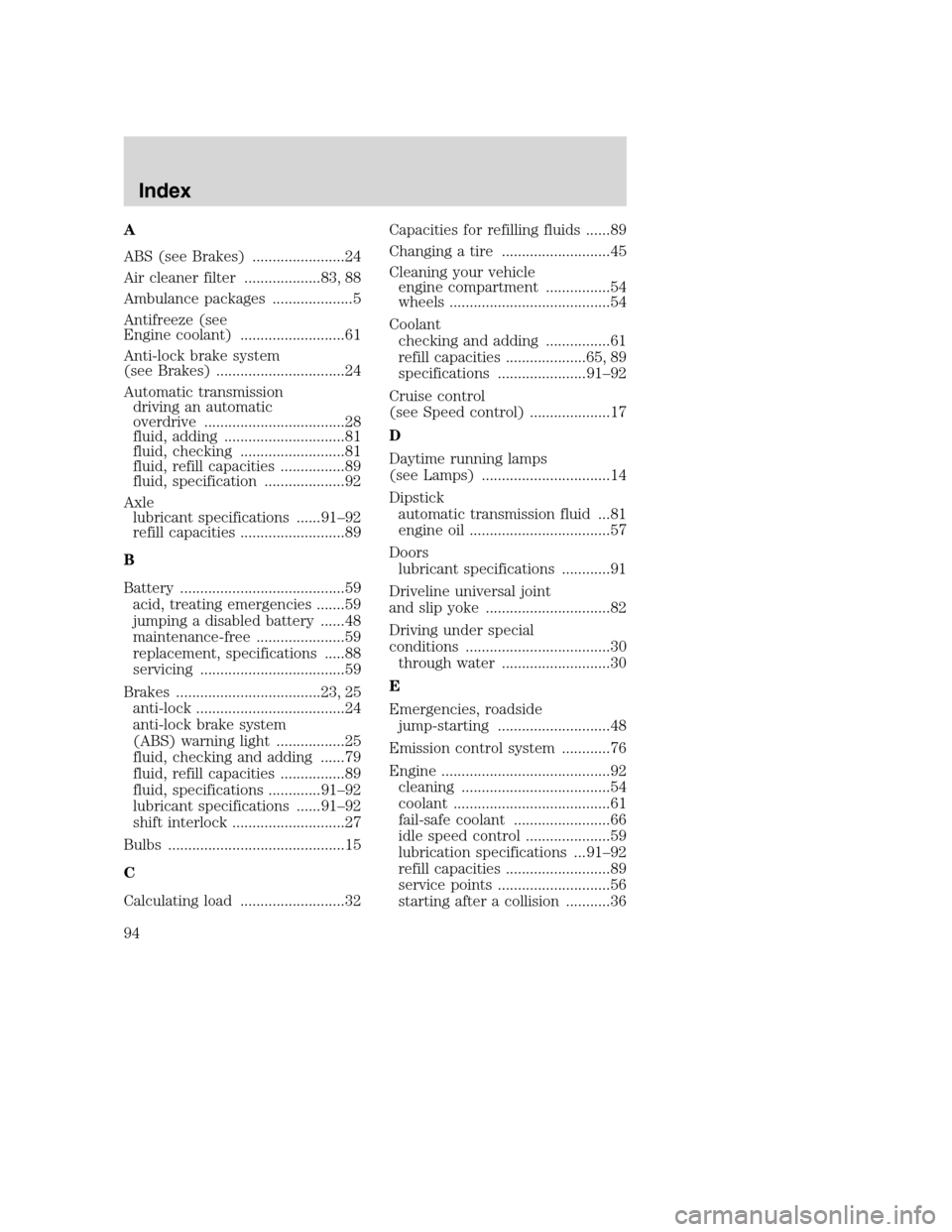
A
ABS (see Brakes) .......................24
Air cleaner filter ...................83, 88
Ambulance packages ....................5
Antifreeze (see
Engine coolant) ..........................61
Anti-lock brake system
(see Brakes) ................................24
Automatic transmission
driving an automatic
overdrive ...................................28
fluid, adding ..............................81
fluid, checking ..........................81
fluid, refill capacities ................89
fluid, specification ....................92
Axle
lubricant specifications ......91–92
refill capacities ..........................89
B
Battery .........................................59
acid, treating emergencies .......59
jumping a disabled battery ......48
maintenance-free ......................59
replacement, specifications .....88
servicing ....................................59
Brakes ....................................23, 25
anti-lock .....................................24
anti-lock brake system
(ABS) warning light .................25
fluid, checking and adding ......79
fluid, refill capacities ................89
fluid, specifications .............91–92
lubricant specifications ......91–92
shift interlock ............................27
Bulbs ............................................15
C
Calculating load ..........................32Capacities for refilling fluids ......89
Changing a tire ...........................45
Cleaning your vehicle
engine compartment ................54
wheels ........................................54
Coolant
checking and adding ................61
refill capacities ....................65, 89
specifications ......................91–92
Cruise control
(see Speed control) ....................17
D
Daytime running lamps
(see Lamps) ................................14
Dipstick
automatic transmission fluid ...81
engine oil ...................................57
Doors
lubricant specifications ............91
Driveline universal joint
and slip yoke ...............................82
Driving under special
conditions ....................................30
through water ...........................30
E
Emergencies, roadside
jump-starting ............................48
Emission control system ............76
Engine ..........................................92
cleaning .....................................54
coolant .......................................61
fail-safe coolant ........................66
idle speed control .....................59
lubrication specifications ...91–92
refill capacities ..........................89
service points ............................56
starting after a collision ...........36
Index
94
Page 96 of 96
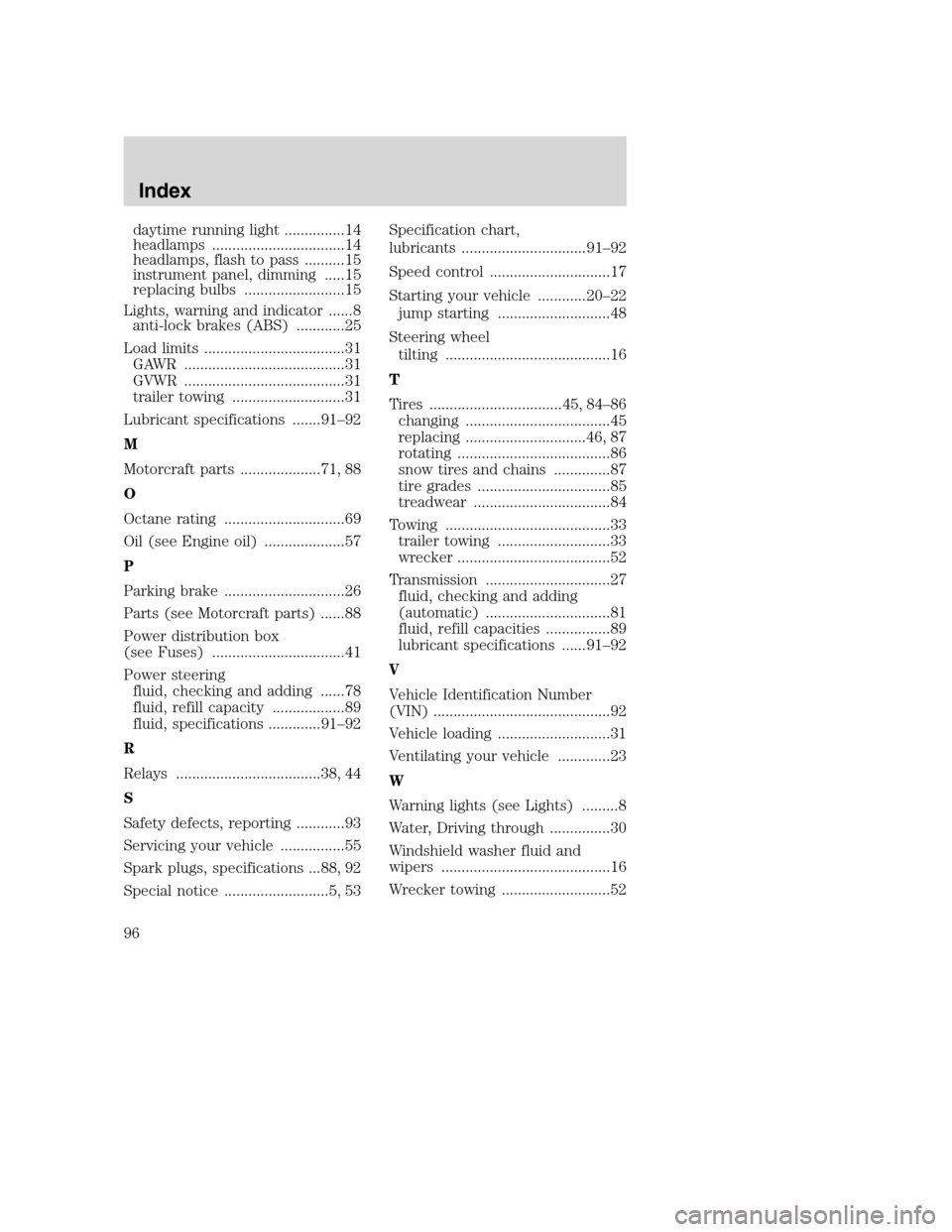
daytime running light ...............14
headlamps .................................14
headlamps, flash to pass ..........15
instrument panel, dimming .....15
replacing bulbs .........................15
Lights, warning and indicator ......8
anti-lock brakes (ABS) ............25
Load limits ...................................31
GAWR ........................................31
GVWR ........................................31
trailer towing ............................31
Lubricant specifications .......91–92
M
Motorcraft parts ....................71, 88
O
Octane rating ..............................69
Oil (see Engine oil) ....................57
P
Parking brake ..............................26
Parts (see Motorcraft parts) ......88
Power distribution box
(see Fuses) .................................41
Power steering
fluid, checking and adding ......78
fluid, refill capacity ..................89
fluid, specifications .............91–92
R
Relays ....................................38, 44
S
Safety defects, reporting ............93
Servicing your vehicle ................55
Spark plugs, specifications ...88, 92
Special notice ..........................5, 53Specification chart,
lubricants ...............................91–92
Speed control ..............................17
Starting your vehicle ............20–22
jump starting ............................48
Steering wheel
tilting .........................................16
T
Tires .................................45, 84–86
changing ....................................45
replacing ..............................46, 87
rotating ......................................86
snow tires and chains ..............87
tire grades .................................85
treadwear ..................................84
Towing .........................................33
trailer towing ............................33
wrecker ......................................52
Transmission ...............................27
fluid, checking and adding
(automatic) ...............................81
fluid, refill capacities ................89
lubricant specifications ......91–92
V
Vehicle Identification Number
(VIN) ............................................92
Vehicle loading ............................31
Ventilating your vehicle .............23
W
Warning lights (see Lights) .........8
Water, Driving through ...............30
Windshield washer fluid and
wipers ..........................................16
Wrecker towing ...........................52
Index
96